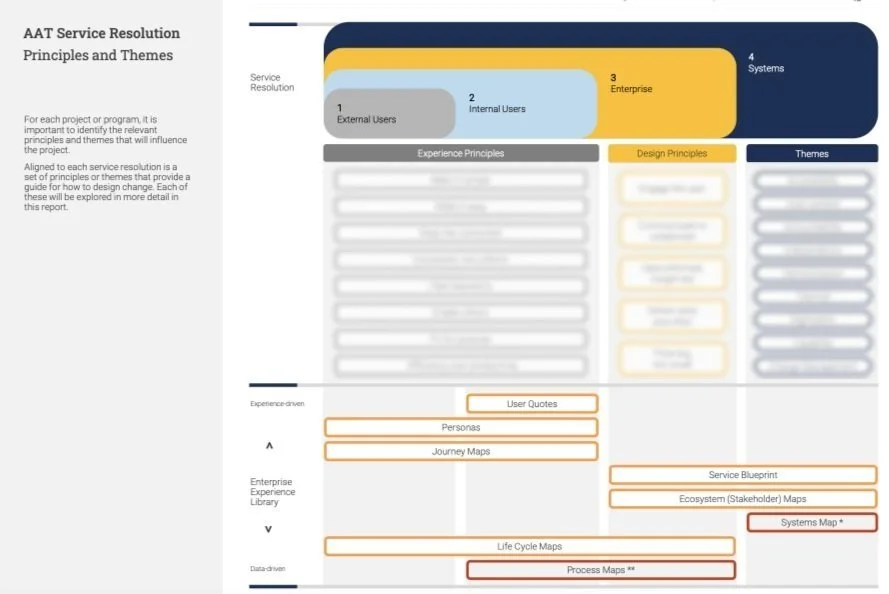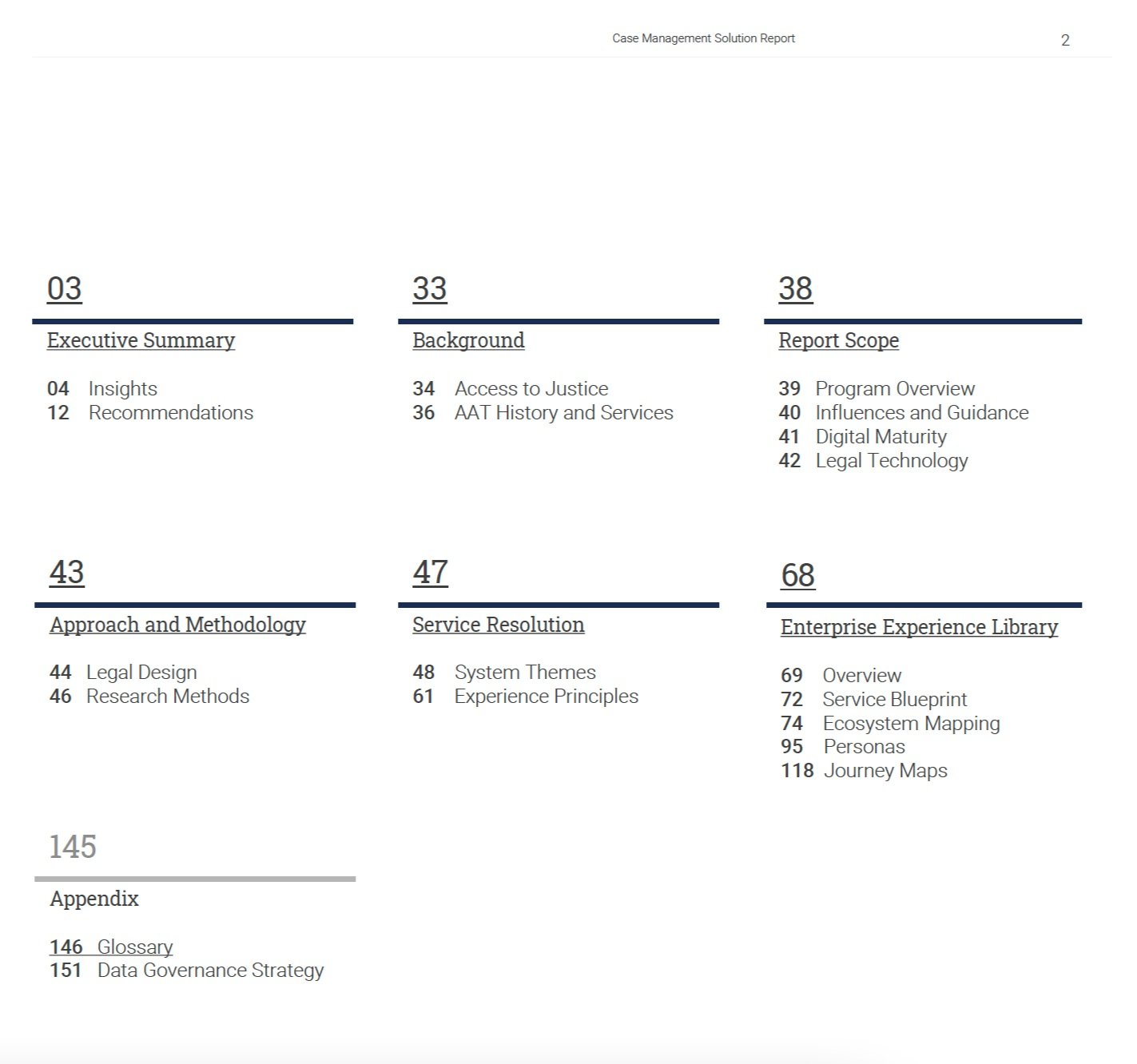Enterprise Experience Research
Administrative Appeals Tribunal
CASE STUDY —
Access to Justice & LegalTech
Service Design, User Experience Design, Design Research, Systems Thinking, Legal Design, Human-centred Design
Capabilities:
Design and implementation of a research program.
Research participant recruitment; conducted 70+ user experience interviews.
Created a library of user experience artefacts including service blueprints, personas, journey maps, user stories.
Established a practice of ongoing human-centred design research.
Synthesises quantitative and qualitative research into themed recommendations.
Report design and establishment of a design system.
Communicated insights to key stakeholders.
Identified opportunities to leverage strategic solutions for disproportionate impact.
-
The Administrative Appeals Tribunal (AAT) provides merit reviews of administrative decisions made under Commonwealth laws. Following amalgamation in 2015, the agency was formed to unite what now comprises the three primary divisions of the AAT- Social Services and Child Support Division (SSCSD), Migration and Refugee Division (MRD) and General and Other Division (G&OD). In 2022, the National Disability Insurance Scheme (NDIS) Division was established as a fourth ‘primary’ division due to the compounding growth in applications. Within each division there are some sub-divisions as well as caseload groupings around specific legislation.
One of the most significant barriers to realising the full potential of amalgamation remains with the ongoing use of legacy technology and differentiated data systems. Inherited from the divisional tribunals, the use of three case management systems was identified as the single most significant barrier to amalgamation and national consistency.
-
The Case Management Solutions Program (CMSP) was established in 2019 to deliver a significant technological uplift to the internal processes of the Tribunal.
As part of the initial Research Phase of the program I was contracted to design, conduct and document the findings of a broad user experience and service design research program.
-
Embedded within the CMSP, I worked alongside a legal researcher to navigate the complex enterprise environment. I operated as the sole service designer and design researcher in a team predominantly comprised of business analysts and public servants. I led the design practice and reported directly to the Program Manager for administrative support and assistance with stakeholder management.
Approach —
The research phase of the CMSP formed a crucial foundation for the team to frame the current problem before defining the potential future solutions.
1 —Discovery
Secondary Research — Gaining context and background by reading various secondary research sources including previous consultant reports, commentaries, legislative review documents and an array of internal corporate documents.
Stakeholder Management— A key factor in the successful delivering of the research phase was ensuring we had the support of senior leadership. I worked closely with the program manager to map out the key stakeholders, understand their motivations and establish rapport. This proved to be a successful tactic as we had the full support of senior leadership who provided invaluable access and resources to the research team as they could see the value in our work.
2 — Engage & validate
Outreach — In order to ensure we were capturing a diverse but accurate representation of the organisation we established a matrix of roles, seniority, gender, tribunal divisions and business areas. Conscious of the paradigm of power, we made an effort to speak with people in roles not only from the breadth of the organisation but also depth, ensuring that we heard the voices of not only senior executives but entry level public servants.
Interview — Alongside my legal researcher counterpart, we conducted 70+ user experience interviews over a period of 6 weeks. We provided a participant preparation pack outlining the purpose and extent of their involvement. We loosely structured the interviews around some key themes but was largely guided by the participants experience, insights and interests.
Reflect — As a team, we built in a weekly review session with the program manager to report back high-level findings, and discuss emerging themes of the work. This helped us to build a practice of reflective interviewing and building on the lessons we’d learned over time.
Overview — Research Methodologies
3 — Analysis & reporting
Synthesising themes — card sorting activity
The image above shows our collaborative process for establishing themes, experience principles, design principles and themes. We integrated key snippets of our findings from all research methods into a single work space and proceeded to categorise, discuss and recategorise. This process was intensive but effective in that it helped us to challenge our own biases and perception. The team worked through this process flexibly and intuitively, grounding our process in psychological safety and openness to new ideas.
Zooming in and out — ‘Service Resolution’
The application of experience principles, design principles and themes were explained through a model of ‘Service Resolution’. The analogy of resolution was central to our research approach that focussed on the need to zoom in and out of the problem space. The highest resolution focused on the specific experience principles for each user group whilst the themes took a holistic systems lens across the organisation and i’s broader context. Describing the relationship of these resolutions to the design artefacts helped us to articulate the purpose and limitations of each typology and emphasised the interplay of artefacts to tell a comprehensive story of the enterprise experience at different scales.
Fusing quantitative with qualitative insights — design artefacts
I led the design of a suite of service design artefacts — user stories, personas, journey maps, service blueprint, ecosystem maps, lifecycle maps, systems maps — to document and visualise the enterprise experience research. We integrated our insights from the qualitative design research with the rigorous process mapping and quantitative data insights produced by the business analysts.
Below are some examples of persona and journey map templates as well as an overview of all assets in the Enterprise Experience Library.
A NOTE ON RESEARCH ETHICS
Due to the nature of the content in this piece of work, I’m not at liberty to share the contents of the artefacts.
Please get in touch to request a private portfolio of selected artefacts.
Delivery —
I was responsible for the visual design, formatting and co-authoring the 160-page ‘CMSP Enterprise Experience Research Report’ that was delivered on schedule in June and published in September 2021.
The report included eight major recommendations to guide the program and the organisation into the next phase of the CMSP. The report also included the first publication of the AAT Enterprise Experience Library.
Professionally —
Contract extended & promotion to practice lead
At the successful completion of the research report task, I was offered a contract continuation and was promoted to the role of Strategic Design Lead. In the role, my focus was to continue to embed service design, user experience research and systems thinking capabilities into the CMSP and the broader organisation.
Enterprise —
Building capability in new ways of working and thinking
The CMSP and the broader Enterprise Technology Group is being used to pilot a number of new ways of working including the adoption of agile ways of working. The introduction of systems thinking in the research report was a key step towards a broader organisational pull to increase enterprise capability in systems and design thinking.
Program —
Perception change: ‘beyond technology’
One of the central messages we were hoping to convey is that whilst the CMSP is committed to delivering a new case management system, the program scope extends beyond being purely technological solutions. The introduction of systems thinking emphasised that beneath the surface there are strategic, structural and cultural factors that should be addressed in order to enable the successful delivery of a technical solution.
Outcomes
Next — Case Study
<
If you have any questions about this case study,
or want to know more about my approach please get in touch.









